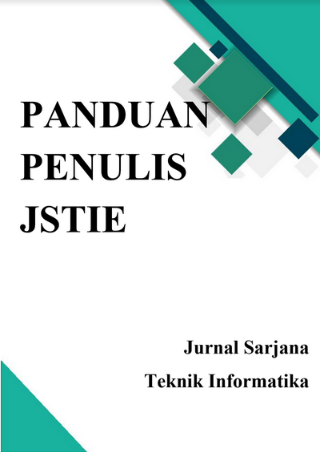ANALISIS PERBANDINGAN METODE LI DAN CHAN-VESE PADA PROSES SEGMENTASI CITRA DIGITAL
DOI:
https://doi.org/10.12928/jstie.v1i2.2591Abstract
Suatu data tidak terbatas berupa teks, tetapi juga berupa citra, audio, dan video. Citra merupakan salah satu komponen multimedia yang memiliki peranan penting yaitu sebagai bentuk informasi visual. Segmentasi citra memegang peranan penting dalam analisis citra, yaitu pengenalan objek. Pengenalan suatu objek (object recognition) diawali dengan proses segmentasi. Segmentasi merupakan proses memisahkan citra menjadi bagian-bagian pembentuknya. Dalam proses segmentasi, tidak semua citra berhasil dikenali seluruh polanya, sehingga diperlukan beberapa metode untuk menganalisis proses segmentasi pada citra digital. Adanya permasalahan tersebut, sehingga akan dikembangkan penelitian untuk menganalisis perbandingan metode Li dan Chan-Vese pada proses segmentasi citra digital.
Subjek penelitian adalah menganalisis kinerja metode Li dan Chan-Vese pada proses segmentasi citra digital. Langkah dalam menganalisis kinerja kedua metode tersebut diawali dengan analisis kebutuhan sistem, perancangan diagram alir, perancangan sistem, perancangan interface, implementasi sistem dengan Matlab 7.6, dan pengujian dengan membandingkan empat citra, yaitu citra medis, citra real, citra aerial, dan citra sintetis.
Hasil penelitian dengan menggunakan 40 sampel citra menunjukkan bahwa hasil segmentasi citra menggunakan metode Li mampu mensegmentasi citra secara baik namun terdapat lokalitas jika terdapat lebih dari satu objek dan kontras citra asli yang kurang baik. Sedangkan dengan menggunakan metode Chan-Vese, citra yang tersegmentasi terlebih dahulu yang berada di sekitar kontur awal dan belum sepenuhnya tersegmentasi meskipun nilai iterasi yang digunakan sama dengan metode Li. Pada metode Chan-Vese tidak terjadi lokalitas meskipun objek lebih dari satu. Dari hasil timing run, metode Li rata-rata membutuhkan waktu proses 35.07306 detik, sedangkan metode Chan-Vese rata-rata membutuhkan waktu proses 36.20313 detik. Waktu proses metode Li lebih cepat 1.13007 detik dari pada metode Chan-Vese. Dari hasil SNR, rata-rata nilai SNR metode Li adalah 7.713102 dB dan rata-rata nilai SNR metode Chan-Vese adalah 3.674622 dB, sehingga dapat diketahui bahwa kualitas citra hasil segmentasi metode Li lebih baik dari pada kualitas citra segmentasi metode Chan-Vese.
Kata kunci : Chan-Vese, Li, Segmentasi citra.References
http://www.informatika.org/~rinaldi/Buku/Pengolahan%20Citra%20Digital/Bab-1_Pengantar%20Pengolahan%20Citra.pdf (diakses tanggal 28 Oktober 2011)
http://ussie.staff.gunadarma.ac.id/Downloads/files/13803/segmentasi+Aniati.pdf (diakses tanggal 2 November 2011)
Thomas Brox and Joachim Weickert. Level Set Based Image Segmentation with Multiple Regions. Mathematical Image Analysis Group, Faculty of Mathematics and Computer Science, Saarland University, Building 27, 66041 Saarbrücken, Germany.
http://en.wikipedia.org/wiki/Level_set_method (diakses tanggal 31 Mei 2012)
T. Chan and L. Vese. Active contours without edges. IEEE Trans. Image Process., vol. 10, pp. 266-277, February 2001.
C. Li, C.-Y. Kao, J. C. Gore, and Z. Ding. Minimization of region-scalable fitting energy for image segmentation. IEEE Trans. Image Process., vol. 17, pp. 1940-1949, 2008.
C. Li, C. Xu, C. Gui, and M. D. Fox. Level set evolution without re-initialization: A new variational formulation. in Proc. IEEE Conf. Computer Vision and Pattern Recognition, 2005, vol. 1, pp. 430-436
http://journal.mercubuana.ac.id/data/8%20Olah%20Citra-Konsep%20Dasar.pdf (diakses pada tanggal 28 Oktober 2011)
http://idhaclassroom.com/download/pengolahan-citra/Pengolahan%20Citra.pdf (diakses tanggal 28 Oktober 2011)
Putra, Darma. 2010. Pengolahan Citra Digital. Yogyakarta : ANDI.
http://ussie.staff.gunadarma.ac.id/Downloads/files/13803/segmentasi+Aniati.pdf/ (diakses pada tanggal 1 Juli 2012)
http://puslit2.petra.ac.id/ejournal/index.php/inf/article/download/16778/16758 (diakses pada tanggal 2 November 2011)
http://digilib.petra.ac.id/viewer.php?page=10&submit.x=20&submit.y=17&qual=high&submitval=next&fname=%2Fjiunkpe%2Fs1%2Finfo%2F2006%2Fjiunkpe-ns-s1-2006-26402056-6118-aplikasi_image-chapter2.pdf (diakses pada tanggal 28 Juni 2012)
Cohen, Rami. 2010. The Chan-Vese Algorithm Project Report. Technion, Israel Institute of Technology.
T. Dietenbeck, M. Alessandrini, D. Friboulet, O. Bernard. CREASEG: a free software for the evaluation of image segmentation algorithms based on level-set. In IEEE International Conference On Image Processing. Hongkong, China, 2010.
Munir, Rinaldi. 2004. Pengolahan Citra Digital dengan Pendekatan Algoritmik. Bandung : Informatika.
Suhendra, Adang. 2004. Catatan Kuliah Pengantar Pengolahan Citra. Univesitas Gunadarma.
http://lecturer.eepis-its.edu/~arna/Praktikum_RPL/DFD.pdf (diakses tanggal 28 Mei 2012)
Downloads
Published
Issue
Section
License
License and Copyright Agreement
In submitting the manuscript to the journal, the authors certify that:
- They are authorized by their co-authors to enter into these arrangements.
- The work described has not been formally published before, except in the form of an abstract or as part of a published lecture, review, thesis, or overlay journal. Please also carefully read Journal Posting Your Article Policy.
- The work is not under consideration for publication elsewhere.
- The work has been approved by all the author(s) and by the responsible authorities – tacitly or explicitly – of the institutes where the work has been carried out.
- They secure the right to reproduce any material that has already been published or copyrighted elsewhere.
- They agree to the following license and copyright agreement.
Copyright
Authors who publish with Jurnal Sarjana Teknik Informatika agree to the following terms:
- Authors retain copyright and grant the journal right of first publication with the work simultaneously licensed under a Creative Commons Attribution License (CC BY-SA 4.0) that allows others to share the work with an acknowledgement of the work's authorship and initial publication in this journal.
- Authors are able to enter into separate, additional contractual arrangements for the non-exclusive distribution of the journal's published version of the work (e.g., post it to an institutional repository or publish it in a book), with an acknowledgement of its initial publication in this journal.
- Authors are permitted and encouraged to post their work online (e.g., in institutional repositories or on their website) prior to and during the submission process, as it can lead to productive exchanges, as well as earlier and greater citation of published work.







